The Story Behind the Photograph
Photographing The Ocelot
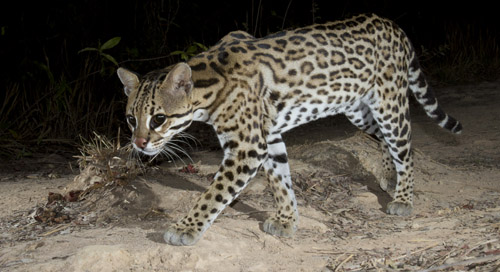
One of two ocelot shots captured within seconds of each other with a Range IR.
For the past five years Mary and I have been traveling to the Pantanal of Brazil to photograph jaguars and other wildlife. Last year, for the first time, I brought along some Trail or Game Cameras and set them up on trails near one of our lodges, hoping to film a jaguar or record some other species.
I was successful, capturing Brocket Deer and Brazilian Tapir, but no jaguars. This year, however, I brought along two Range IRs, an infrared camera tripper that I’ve described in previous Stories Behind the Photograph (see the latest), and several trail cameras. I set up the trail cameras in likely locations and kept them there for the duration of my stay, which totaled nearly four weeks this year. The results: I succeeded in capturing at least two different Jaguars with the game camera, and possibly even more as cats were recorded in several different locations. Normally I use Moultrie Game or Trail Cameras. They have great battery life and have always been dependable. The models I presently use were too large to take on this trip so I used some other models, which worked, but they did not when I tried resetting them for another round of setups. This was frustrating!
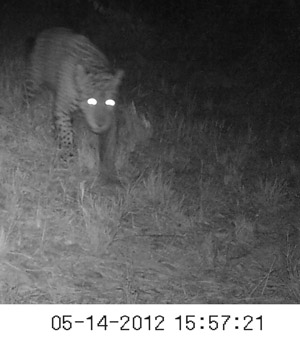
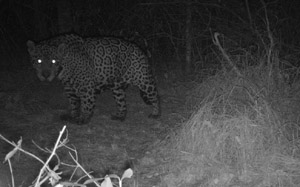
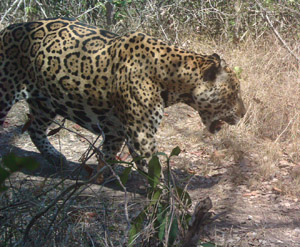
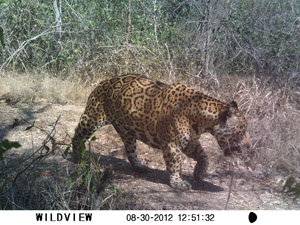
Using several different game cameras at three different locations I confirmed that jaguars were traveling the trails at night, and even at high noon!
On our last photo tour (Jaguars and the Wildlife of the Pantanal Trip 2) I set up a camera along a trail where I’d seen numerous Jaguar tracks the day before. Two jaguars had been seen in the area, probably a mating couple, and the chances were fair that one might pass by. Because I only had one evening for my first setup, and less than an hour of daylight to set up the camera trap using a Range IR, I stupidly chose the easy way out, and positioned the camera to cover the trail at a right angle. Another game trail led into my coverage area so, in theory, I could possibly record cats coming left or right, or straight to me (or away) on the secondary trail. My ‘vision,’ however, was to film a jaguar head-on, at a low angle, and I compromised on that.

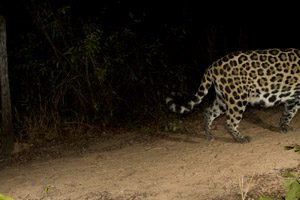
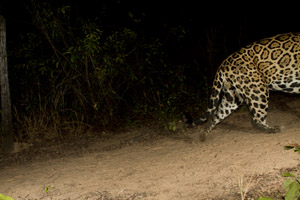
I always test out the triggering and the lighting before I leave the setup. Here I crawled along the trail where I expected the jaguar to pass, but I did not anticipate the speed of the jaguar's travel, especially since the camera had gone to sleep.
You can see, however, how big a jaguar is -- these two stood as high, or higer than me at the shoulder. A female passed first, followed a few minutes later by the male. I was really disappointed to have missed this!
The next morning when I collected the cameras I found I should have followed my vision. I’d captured two jaguars! But both were already walking out of the frame. The camera had ‘gone to sleep,’ and by the time it responded the jaguars had walked partly out of the picture. Even had I achieved a full view, I’d have been disappointed with the image as it would have merely been a side view. Nevertheless, it was exciting to capture a jaguar with the system, and I was certainly encouraged to try again when I returned from five nights in jaguar country.
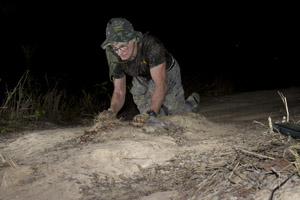
This time I set up so that a jaguar would be facing me, assuming that it walked down the trail. Had I used a StopShot, too, I could have guaranteed that I'd have a jaguar, or other subject, only triggering the camera when it was facing the right way. On the far right side you can see the Range IR aimed at the tripping point. I illuminated the scene with two 430 TTL flashes, triggered by the pop-up flash on my Canon 7D.
When I returned I tried again, setting up the camera so that anything tripping the Range IR beam would either be facing the camera (my hope) or walking away (a risk when not using the StopShot as well). I placed a Canon 7D on a monopod and lashed the pole to a fence post and tree, giving me the low angle I desired. Two Canon 430 flashes, set on slave mode, were positioned on either side of the trail, and the Range IR aimed at a spot where I hoped a cat would pass. The two 430 flashes were set on TTL and triggered by the pop-up flash of the 430. Previously, when I did the jaguar shots I used Manual mode on the flashes, but with limited time I simply didn’t have the time to figure out the menu once again to set the flashes for manual, and so I went with TTL. Some test shots confirmed that should work.
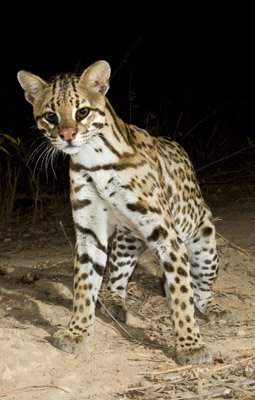
When I returned the next morning at dawn I found I had a couple of misfires but as I scrolled through I was shocked and thrilled to see that I was successful! Instead of a jaguar I had captured two images of an Ocelot, a much smaller and far more difficult cat to see and photograph in the Pantanal.
This was my second real outing on a foreign trip using the Range IR. I’ve always enjoyed the challenge of capturing animals with remote cameras, but all previous products were too large and bulky for this to be practical. The small size of the Range IR lends itself perfectly for this, although now the problem I face is carrying enough flashes to run two or three or four camera traps when in the field. In the area where I captured the Ocelot I’ve also captured tapirs and brocket deer on the game cameras, and the cut-off jaguars, but the possibility also exists for Puma, Crab-eating Raccoons, Jagarundi, and who knows what else. So I suspect I’ll be carrying several Range IRs in the future.
Next year, if our Tiger Photo Safaris go off – right now the Indian Supreme Court has suspended tiger tourism, I’m planning on doing several Range IR camera traps at one of our lodges that has a great waterhole. There, we may get Jungle Cat, Leopard, Wild Boar, Spotted Deer, and who knows what else coming in during the night. I also am hoping that participants of next year’s Jaguar/Pantanal Photo Tour will carry a simple flash system and a Range IR and will join me on the trails for more camera traps. It is a lot of fun and exciting – a bit of Christmas morning anticipation as one scrolls through images. Sometimes, as when I tried a week later a final time, I find coal in the stocking – but that is wildlife photograpy.
The system is simple. All one needs is a three flash system for nice lighting. A camera with a pop-up flash, like a Canon 7D, is ideal for triggering the two slave flashes. Alternatively, a regular hotshoe flash can be used as the master, and one or two (the ideal) can be fired from that.
There is a remote chance that I may do an Advanced Flash Nature Photo Course this year – if you are interested in this, please contact the office and by the response I’ll decide. In that course I'll be covering TTL and Manual flash, and perhaps more importantly, I'll be demonstrating and teaching techniques with the Range IR and you'll be using this equipment in the projects I'll be assigning you. Either way, though, the Range IR camera traps are great, and I’d never had captured an Ocelot shot like this without one.
Read about our Jaguars and the Wildlife of the Pantanal trips
One or Two for 2012
Refer to our BROCHURE to get an idea of next year's trip!
Visit our Trip and Scouting Report Pages for more images and an even better idea of what our trips to the Pantanal are like. There you'll find our archived reports from previous years.
Past Stories Behind the Photograph
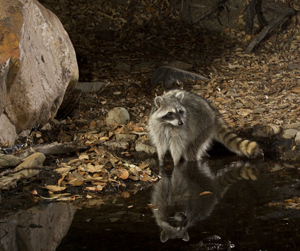
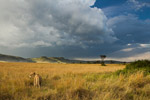

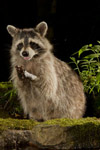
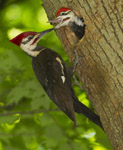


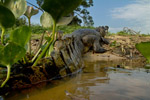
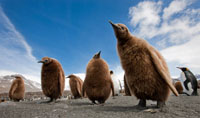
.jpg)
The Waterhole
Bushbaby
Barn Swallow
King Penguin
The Lion and the Landscape
The Bighorn Sheep
The Raccoon
The Pileated Woodpecker
The Striking Rattlesnake
The Pink Salmon
The Spectacled Caimen
Check out our latest web site,
mcdonaldwildlifephotos.com
where we'll be adding portfolios and eventually building up
a searchable data base for photo buyers. We've just started,
and the selection is limited, but it is still worth a visit!
Office Phone: (717) 543-6423
Or FAX us at: (717) 543-5342
The Story Behind the Photograph
Photographing The Ocelot

One of two ocelot shots captured within seconds of each other with a Range IR.
For the past five years Mary and I have been traveling to the Pantanal of Brazil to photograph jaguars and other wildlife. Last year, for the first time, I brought along some Trail or Game Cameras and set them up on trails near one of our lodges, hoping to film a jaguar or record some other species.
I was successful, capturing Brocket Deer and Brazilian Tapir, but no jaguars. This year, however, I brought along two Range IRs, an infrared camera tripper that I’ve described in previous Stories Behind the Photograph (see the latest), and several trail cameras. I set up the trail cameras in likely locations and kept them there for the duration of my stay, which totaled nearly four weeks this year. The results: I succeeded in capturing at least two different Jaguars with the game camera, and possibly even more as cats were recorded in several different locations. Normally I use Moultrie Game or Trail Cameras. They have great battery life and have always been dependable. The models I presently use were too large to take on this trip so I used some other models, which worked, but they did not when I tried resetting them for another round of setups. This was frustrating!




Using several different game cameras at three different locations I confirmed that jaguars were traveling the trails at night, and even at high noon!
On our last photo tour (Jaguars and the Wildlife of the Pantanal Trip 2) I set up a camera along a trail where I’d seen numerous Jaguar tracks the day before. Two jaguars had been seen in the area, probably a mating couple, and the chances were fair that one might pass by. Because I only had one evening for my first setup, and less than an hour of daylight to set up the camera trap using a Range IR, I stupidly chose the easy way out, and positioned the camera to cover the trail at a right angle. Another game trail led into my coverage area so, in theory, I could possibly record cats coming left or right, or straight to me (or away) on the secondary trail. My ‘vision,’ however, was to film a jaguar head-on, at a low angle, and I compromised on that.



I always test out the triggering and the lighting before I leave the setup. Here I crawled along the trail where I expected the jaguar to pass, but I did not anticipate the speed of the jaguar's travel, especially since the camera had gone to sleep.
You can see, however, how big a jaguar is -- these two stood as high, or higer than me at the shoulder. A female passed first, followed a few minutes later by the male. I was really disappointed to have missed this!
The next morning when I collected the cameras I found I should have followed my vision. I’d captured two jaguars! But both were already walking out of the frame. The camera had ‘gone to sleep,’ and by the time it responded the jaguars had walked partly out of the picture. Even had I achieved a full view, I’d have been disappointed with the image as it would have merely been a side view. Nevertheless, it was exciting to capture a jaguar with the system, and I was certainly encouraged to try again when I returned from five nights in jaguar country.

This time I set up so that a jaguar would be facing me, assuming that it walked down the trail. Had I used a StopShot, too, I could have guaranteed that I'd have a jaguar, or other subject, only triggering the camera when it was facing the right way. On the far right side you can see the Range IR aimed at the tripping point. I illuminated the scene with two 430 TTL flashes, triggered by the pop-up flash on my Canon 7D.
When I returned I tried again, setting up the camera so that anything tripping the Range IR beam would either be facing the camera (my hope) or walking away (a risk when not using the StopShot as well). I placed a Canon 7D on a monopod and lashed the pole to a fence post and tree, giving me the low angle I desired. Two Canon 430 flashes, set on slave mode, were positioned on either side of the trail, and the Range IR aimed at a spot where I hoped a cat would pass. The two 430 flashes were set on TTL and triggered by the pop-up flash of the 430. Previously, when I did the jaguar shots I used Manual mode on the flashes, but with limited time I simply didn’t have the time to figure out the menu once again to set the flashes for manual, and so I went with TTL. Some test shots confirmed that should work.

When I returned the next morning at dawn I found I had a couple of misfires but as I scrolled through I was shocked and thrilled to see that I was successful! Instead of a jaguar I had captured two images of an Ocelot, a much smaller and far more difficult cat to see and photograph in the Pantanal.
This was my second real outing on a foreign trip using the Range IR. I’ve always enjoyed the challenge of capturing animals with remote cameras, but all previous products were too large and bulky for this to be practical. The small size of the Range IR lends itself perfectly for this, although now the problem I face is carrying enough flashes to run two or three or four camera traps when in the field. In the area where I captured the Ocelot I’ve also captured tapirs and brocket deer on the game cameras, and the cut-off jaguars, but the possibility also exists for Puma, Crab-eating Raccoons, Jagarundi, and who knows what else. So I suspect I’ll be carrying several Range IRs in the future.
Next year, if our Tiger Photo Safaris go off – right now the Indian Supreme Court has suspended tiger tourism, I’m planning on doing several Range IR camera traps at one of our lodges that has a great waterhole. There, we may get Jungle Cat, Leopard, Wild Boar, Spotted Deer, and who knows what else coming in during the night. I also am hoping that participants of next year’s Jaguar/Pantanal Photo Tour will carry a simple flash system and a Range IR and will join me on the trails for more camera traps. It is a lot of fun and exciting – a bit of Christmas morning anticipation as one scrolls through images. Sometimes, as when I tried a week later a final time, I find coal in the stocking – but that is wildlife photograpy.
The system is simple. All one needs is a three flash system for nice lighting. A camera with a pop-up flash, like a Canon 7D, is ideal for triggering the two slave flashes. Alternatively, a regular hotshoe flash can be used as the master, and one or two (the ideal) can be fired from that.
There is a remote chance that I may do an Advanced Flash Nature Photo Course this year – if you are interested in this, please contact the office and by the response I’ll decide. In that course I'll be covering TTL and Manual flash, and perhaps more importantly, I'll be demonstrating and teaching techniques with the Range IR and you'll be using this equipment in the projects I'll be assigning you. Either way, though, the Range IR camera traps are great, and I’d never had captured an Ocelot shot like this without one.
Read about our Jaguars and the Wildlife of the Pantanal trips
One or Two for 2012
Refer to our BROCHURE to get an idea of next year's trip!
Visit our Trip and Scouting Report Pages for more images and an even better idea of what our trips to the Pantanal are like. There you'll find our archived reports from previous years.
The Story Behind the Photograph
Photographing The Ocelot

One of two ocelot shots captured within seconds of each other with a Range IR.
For the past five years Mary and I have been traveling to the Pantanal of Brazil to photograph jaguars and other wildlife. Last year, for the first time, I brought along some Trail or Game Cameras and set them up on trails near one of our lodges, hoping to film a jaguar or record some other species.
I was successful, capturing Brocket Deer and Brazilian Tapir, but no jaguars. This year, however, I brought along two Range IRs, an infrared camera tripper that I’ve described in previous Stories Behind the Photograph (see the latest), and several trail cameras. I set up the trail cameras in likely locations and kept them there for the duration of my stay, which totaled nearly four weeks this year. The results: I succeeded in capturing at least two different Jaguars with the game camera, and possibly even more as cats were recorded in several different locations. Normally I use Moultrie Game or Trail Cameras. They have great battery life and have always been dependable. The models I presently use were too large to take on this trip so I used some other models, which worked, but they did not when I tried resetting them for another round of setups. This was frustrating!




Using several different game cameras at three different locations I confirmed that jaguars were traveling the trails at night, and even at high noon!
On our last photo tour (Jaguars and the Wildlife of the Pantanal Trip 2) I set up a camera along a trail where I’d seen numerous Jaguar tracks the day before. Two jaguars had been seen in the area, probably a mating couple, and the chances were fair that one might pass by. Because I only had one evening for my first setup, and less than an hour of daylight to set up the camera trap using a Range IR, I stupidly chose the easy way out, and positioned the camera to cover the trail at a right angle. Another game trail led into my coverage area so, in theory, I could possibly record cats coming left or right, or straight to me (or away) on the secondary trail. My ‘vision,’ however, was to film a jaguar head-on, at a low angle, and I compromised on that.



I always test out the triggering and the lighting before I leave the setup. Here I crawled along the trail where I expected the jaguar to pass, but I did not anticipate the speed of the jaguar's travel, especially since the camera had gone to sleep.
You can see, however, how big a jaguar is -- these two stood as high, or higer than me at the shoulder. A female passed first, followed a few minutes later by the male. I was really disappointed to have missed this!
The next morning when I collected the cameras I found I should have followed my vision. I’d captured two jaguars! But both were already walking out of the frame. The camera had ‘gone to sleep,’ and by the time it responded the jaguars had walked partly out of the picture. Even had I achieved a full view, I’d have been disappointed with the image as it would have merely been a side view. Nevertheless, it was exciting to capture a jaguar with the system, and I was certainly encouraged to try again when I returned from five nights in jaguar country.

This time I set up so that a jaguar would be facing me, assuming that it walked down the trail. Had I used a StopShot, too, I could have guaranteed that I'd have a jaguar, or other subject, only triggering the camera when it was facing the right way. On the far right side you can see the Range IR aimed at the tripping point. I illuminated the scene with two 430 TTL flashes, triggered by the pop-up flash on my Canon 7D.
When I returned I tried again, setting up the camera so that anything tripping the Range IR beam would either be facing the camera (my hope) or walking away (a risk when not using the StopShot as well). I placed a Canon 7D on a monopod and lashed the pole to a fence post and tree, giving me the low angle I desired. Two Canon 430 flashes, set on slave mode, were positioned on either side of the trail, and the Range IR aimed at a spot where I hoped a cat would pass. The two 430 flashes were set on TTL and triggered by the pop-up flash of the 430. Previously, when I did the jaguar shots I used Manual mode on the flashes, but with limited time I simply didn’t have the time to figure out the menu once again to set the flashes for manual, and so I went with TTL. Some test shots confirmed that should work.

When I returned the next morning at dawn I found I had a couple of misfires but as I scrolled through I was shocked and thrilled to see that I was successful! Instead of a jaguar I had captured two images of an Ocelot, a much smaller and far more difficult cat to see and photograph in the Pantanal.
This was my second real outing on a foreign trip using the Range IR. I’ve always enjoyed the challenge of capturing animals with remote cameras, but all previous products were too large and bulky for this to be practical. The small size of the Range IR lends itself perfectly for this, although now the problem I face is carrying enough flashes to run two or three or four camera traps when in the field. In the area where I captured the Ocelot I’ve also captured tapirs and brocket deer on the game cameras, and the cut-off jaguars, but the possibility also exists for Puma, Crab-eating Raccoons, Jagarundi, and who knows what else. So I suspect I’ll be carrying several Range IRs in the future.
Next year, if our Tiger Photo Safaris go off – right now the Indian Supreme Court has suspended tiger tourism, I’m planning on doing several Range IR camera traps at one of our lodges that has a great waterhole. There, we may get Jungle Cat, Leopard, Wild Boar, Spotted Deer, and who knows what else coming in during the night. I also am hoping that participants of next year’s Jaguar/Pantanal Photo Tour will carry a simple flash system and a Range IR and will join me on the trails for more camera traps. It is a lot of fun and exciting – a bit of Christmas morning anticipation as one scrolls through images. Sometimes, as when I tried a week later a final time, I find coal in the stocking – but that is wildlife photograpy.
The system is simple. All one needs is a three flash system for nice lighting. A camera with a pop-up flash, like a Canon 7D, is ideal for triggering the two slave flashes. Alternatively, a regular hotshoe flash can be used as the master, and one or two (the ideal) can be fired from that.
There is a remote chance that I may do an Advanced Flash Nature Photo Course this year – if you are interested in this, please contact the office and by the response I’ll decide. In that course I'll be covering TTL and Manual flash, and perhaps more importantly, I'll be demonstrating and teaching techniques with the Range IR and you'll be using this equipment in the projects I'll be assigning you. Either way, though, the Range IR camera traps are great, and I’d never had captured an Ocelot shot like this without one.
Read about our Jaguars and the Wildlife of the Pantanal trips
One or Two for 2012
Refer to our BROCHURE to get an idea of next year's trip!
Visit our Trip and Scouting Report Pages for more images and an even better idea of what our trips to the Pantanal are like. There you'll find our archived reports from previous years.
The Story Behind the Photograph
Photographing The Ocelot

One of two ocelot shots captured within seconds of each other with a Range IR.
For the past five years Mary and I have been traveling to the Pantanal of Brazil to photograph jaguars and other wildlife. Last year, for the first time, I brought along some Trail or Game Cameras and set them up on trails near one of our lodges, hoping to film a jaguar or record some other species.
I was successful, capturing Brocket Deer and Brazilian Tapir, but no jaguars. This year, however, I brought along two Range IRs, an infrared camera tripper that I’ve described in previous Stories Behind the Photograph (see the latest), and several trail cameras. I set up the trail cameras in likely locations and kept them there for the duration of my stay, which totaled nearly four weeks this year. The results: I succeeded in capturing at least two different Jaguars with the game camera, and possibly even more as cats were recorded in several different locations. Normally I use Moultrie Game or Trail Cameras. They have great battery life and have always been dependable. The models I presently use were too large to take on this trip so I used some other models, which worked, but they did not when I tried resetting them for another round of setups. This was frustrating!




Using several different game cameras at three different locations I confirmed that jaguars were traveling the trails at night, and even at high noon!
On our last photo tour (Jaguars and the Wildlife of the Pantanal Trip 2) I set up a camera along a trail where I’d seen numerous Jaguar tracks the day before. Two jaguars had been seen in the area, probably a mating couple, and the chances were fair that one might pass by. Because I only had one evening for my first setup, and less than an hour of daylight to set up the camera trap using a Range IR, I stupidly chose the easy way out, and positioned the camera to cover the trail at a right angle. Another game trail led into my coverage area so, in theory, I could possibly record cats coming left or right, or straight to me (or away) on the secondary trail. My ‘vision,’ however, was to film a jaguar head-on, at a low angle, and I compromised on that.



I always test out the triggering and the lighting before I leave the setup. Here I crawled along the trail where I expected the jaguar to pass, but I did not anticipate the speed of the jaguar's travel, especially since the camera had gone to sleep.
You can see, however, how big a jaguar is -- these two stood as high, or higer than me at the shoulder. A female passed first, followed a few minutes later by the male. I was really disappointed to have missed this!
The next morning when I collected the cameras I found I should have followed my vision. I’d captured two jaguars! But both were already walking out of the frame. The camera had ‘gone to sleep,’ and by the time it responded the jaguars had walked partly out of the picture. Even had I achieved a full view, I’d have been disappointed with the image as it would have merely been a side view. Nevertheless, it was exciting to capture a jaguar with the system, and I was certainly encouraged to try again when I returned from five nights in jaguar country.

This time I set up so that a jaguar would be facing me, assuming that it walked down the trail. Had I used a StopShot, too, I could have guaranteed that I'd have a jaguar, or other subject, only triggering the camera when it was facing the right way. On the far right side you can see the Range IR aimed at the tripping point. I illuminated the scene with two 430 TTL flashes, triggered by the pop-up flash on my Canon 7D.
When I returned I tried again, setting up the camera so that anything tripping the Range IR beam would either be facing the camera (my hope) or walking away (a risk when not using the StopShot as well). I placed a Canon 7D on a monopod and lashed the pole to a fence post and tree, giving me the low angle I desired. Two Canon 430 flashes, set on slave mode, were positioned on either side of the trail, and the Range IR aimed at a spot where I hoped a cat would pass. The two 430 flashes were set on TTL and triggered by the pop-up flash of the 430. Previously, when I did the jaguar shots I used Manual mode on the flashes, but with limited time I simply didn’t have the time to figure out the menu once again to set the flashes for manual, and so I went with TTL. Some test shots confirmed that should work.

When I returned the next morning at dawn I found I had a couple of misfires but as I scrolled through I was shocked and thrilled to see that I was successful! Instead of a jaguar I had captured two images of an Ocelot, a much smaller and far more difficult cat to see and photograph in the Pantanal.
This was my second real outing on a foreign trip using the Range IR. I’ve always enjoyed the challenge of capturing animals with remote cameras, but all previous products were too large and bulky for this to be practical. The small size of the Range IR lends itself perfectly for this, although now the problem I face is carrying enough flashes to run two or three or four camera traps when in the field. In the area where I captured the Ocelot I’ve also captured tapirs and brocket deer on the game cameras, and the cut-off jaguars, but the possibility also exists for Puma, Crab-eating Raccoons, Jagarundi, and who knows what else. So I suspect I’ll be carrying several Range IRs in the future.
Next year, if our Tiger Photo Safaris go off – right now the Indian Supreme Court has suspended tiger tourism, I’m planning on doing several Range IR camera traps at one of our lodges that has a great waterhole. There, we may get Jungle Cat, Leopard, Wild Boar, Spotted Deer, and who knows what else coming in during the night. I also am hoping that participants of next year’s Jaguar/Pantanal Photo Tour will carry a simple flash system and a Range IR and will join me on the trails for more camera traps. It is a lot of fun and exciting – a bit of Christmas morning anticipation as one scrolls through images. Sometimes, as when I tried a week later a final time, I find coal in the stocking – but that is wildlife photograpy.
The system is simple. All one needs is a three flash system for nice lighting. A camera with a pop-up flash, like a Canon 7D, is ideal for triggering the two slave flashes. Alternatively, a regular hotshoe flash can be used as the master, and one or two (the ideal) can be fired from that.
There is a remote chance that I may do an Advanced Flash Nature Photo Course this year – if you are interested in this, please contact the office and by the response I’ll decide. In that course I'll be covering TTL and Manual flash, and perhaps more importantly, I'll be demonstrating and teaching techniques with the Range IR and you'll be using this equipment in the projects I'll be assigning you. Either way, though, the Range IR camera traps are great, and I’d never had captured an Ocelot shot like this without one.
The Story Behind the Photograph
Photographing The Ocelot

One of two ocelot shots captured within seconds of each other with a Range IR.
For the past five years Mary and I have been traveling to the Pantanal of Brazil to photograph jaguars and other wildlife. Last year, for the first time, I brought along some Trail or Game Cameras and set them up on trails near one of our lodges, hoping to film a jaguar or record some other species.
I was successful, capturing Brocket Deer and Brazilian Tapir, but no jaguars. This year, however, I brought along two Range IRs, an infrared camera tripper that I’ve described in previous Stories Behind the Photograph (see the latest), and several trail cameras. I set up the trail cameras in likely locations and kept them there for the duration of my stay, which totaled nearly four weeks this year. The results: I succeeded in capturing at least two different Jaguars with the game camera, and possibly even more as cats were recorded in several different locations. Normally I use Moultrie Game or Trail Cameras. They have great battery life and have always been dependable. The models I presently use were too large to take on this trip so I used some other models, which worked, but they did not when I tried resetting them for another round of setups. This was frustrating!




Using several different game cameras at three different locations I confirmed that jaguars were traveling the trails at night, and even at high noon!
On our last photo tour (Jaguars and the Wildlife of the Pantanal Trip 2) I set up a camera along a trail where I’d seen numerous Jaguar tracks the day before. Two jaguars had been seen in the area, probably a mating couple, and the chances were fair that one might pass by. Because I only had one evening for my first setup, and less than an hour of daylight to set up the camera trap using a Range IR, I stupidly chose the easy way out, and positioned the camera to cover the trail at a right angle. Another game trail led into my coverage area so, in theory, I could possibly record cats coming left or right, or straight to me (or away) on the secondary trail. My ‘vision,’ however, was to film a jaguar head-on, at a low angle, and I compromised on that.



I always test out the triggering and the lighting before I leave the setup. Here I crawled along the trail where I expected the jaguar to pass, but I did not anticipate the speed of the jaguar's travel, especially since the camera had gone to sleep.
You can see, however, how big a jaguar is -- these two stood as high, or higer than me at the shoulder. A female passed first, followed a few minutes later by the male. I was really disappointed to have missed this!
The next morning when I collected the cameras I found I should have followed my vision. I’d captured two jaguars! But both were already walking out of the frame. The camera had ‘gone to sleep,’ and by the time it responded the jaguars had walked partly out of the picture. Even had I achieved a full view, I’d have been disappointed with the image as it would have merely been a side view. Nevertheless, it was exciting to capture a jaguar with the system, and I was certainly encouraged to try again when I returned from five nights in jaguar country.

This time I set up so that a jaguar would be facing me, assuming that it walked down the trail. Had I used a StopShot, too, I could have guaranteed that I'd have a jaguar, or other subject, only triggering the camera when it was facing the right way. On the far right side you can see the Range IR aimed at the tripping point. I illuminated the scene with two 430 TTL flashes, triggered by the pop-up flash on my Canon 7D.
When I returned I tried again, setting up the camera so that anything tripping the Range IR beam would either be facing the camera (my hope) or walking away (a risk when not using the StopShot as well). I placed a Canon 7D on a monopod and lashed the pole to a fence post and tree, giving me the low angle I desired. Two Canon 430 flashes, set on slave mode, were positioned on either side of the trail, and the Range IR aimed at a spot where I hoped a cat would pass. The two 430 flashes were set on TTL and triggered by the pop-up flash of the 430. Previously, when I did the jaguar shots I used Manual mode on the flashes, but with limited time I simply didn’t have the time to figure out the menu once again to set the flashes for manual, and so I went with TTL. Some test shots confirmed that should work.

When I returned the next morning at dawn I found I had a couple of misfires but as I scrolled through I was shocked and thrilled to see that I was successful! Instead of a jaguar I had captured two images of an Ocelot, a much smaller and far more difficult cat to see and photograph in the Pantanal.
This was my second real outing on a foreign trip using the Range IR. I’ve always enjoyed the challenge of capturing animals with remote cameras, but all previous products were too large and bulky for this to be practical. The small size of the Range IR lends itself perfectly for this, although now the problem I face is carrying enough flashes to run two or three or four camera traps when in the field. In the area where I captured the Ocelot I’ve also captured tapirs and brocket deer on the game cameras, and the cut-off jaguars, but the possibility also exists for Puma, Crab-eating Raccoons, Jagarundi, and who knows what else. So I suspect I’ll be carrying several Range IRs in the future.
Next year, if our Tiger Photo Safaris go off – right now the Indian Supreme Court has suspended tiger tourism, I’m planning on doing several Range IR camera traps at one of our lodges that has a great waterhole. There, we may get Jungle Cat, Leopard, Wild Boar, Spotted Deer, and who knows what else coming in during the night. I also am hoping that participants of next year’s Jaguar/Pantanal Photo Tour will carry a simple flash system and a Range IR and will join me on the trails for more camera traps. It is a lot of fun and exciting – a bit of Christmas morning anticipation as one scrolls through images. Sometimes, as when I tried a week later a final time, I find coal in the stocking – but that is wildlife photograpy.
The system is simple. All one needs is a three flash system for nice lighting. A camera with a pop-up flash, like a Canon 7D, is ideal for triggering the two slave flashes. Alternatively, a regular hotshoe flash can be used as the master, and one or two (the ideal) can be fired from that.
There is a remote chance that I may do an Advanced Flash Nature Photo Course this year – if you are interested in this, please contact the office and by the response I’ll decide. In that course I'll be covering TTL and Manual flash, and perhaps more importantly, I'll be demonstrating and teaching techniques with the Range IR and you'll be using this equipment in the projects I'll be assigning you. Either way, though, the Range IR camera traps are great, and I’d never had captured an Ocelot shot like this without one.
The Story Behind the Photograph
Photographing The Ocelot

One of two ocelot shots captured within seconds of each other with a Range IR.
For the past five years Mary and I have been traveling to the Pantanal of Brazil to photograph jaguars and other wildlife. Last year, for the first time, I brought along some Trail or Game Cameras and set them up on trails near one of our lodges, hoping to film a jaguar or record some other species.
I was successful, capturing Brocket Deer and Brazilian Tapir, but no jaguars. This year, however, I brought along two Range IRs, an infrared camera tripper that I’ve described in previous Stories Behind the Photograph (see the latest), and several trail cameras. I set up the trail cameras in likely locations and kept them there for the duration of my stay, which totaled nearly four weeks this year. The results: I succeeded in capturing at least two different Jaguars with the game camera, and possibly even more as cats were recorded in several different locations. Normally I use Moultrie Game or Trail Cameras. They have great battery life and have always been dependable. The models I presently use were too large to take on this trip so I used some other models, which worked, but they did not when I tried resetting them for another round of setups. This was frustrating!




Using several different game cameras at three different locations I confirmed that jaguars were traveling the trails at night, and even at high noon!
On our last photo tour (Jaguars and the Wildlife of the Pantanal Trip 2) I set up a camera along a trail where I’d seen numerous Jaguar tracks the day before. Two jaguars had been seen in the area, probably a mating couple, and the chances were fair that one might pass by. Because I only had one evening for my first setup, and less than an hour of daylight to set up the camera trap using a Range IR, I stupidly chose the easy way out, and positioned the camera to cover the trail at a right angle. Another game trail led into my coverage area so, in theory, I could possibly record cats coming left or right, or straight to me (or away) on the secondary trail. My ‘vision,’ however, was to film a jaguar head-on, at a low angle, and I compromised on that.



I always test out the triggering and the lighting before I leave the setup. Here I crawled along the trail where I expected the jaguar to pass, but I did not anticipate the speed of the jaguar's travel, especially since the camera had gone to sleep.
You can see, however, how big a jaguar is -- these two stood as high, or higer than me at the shoulder. A female passed first, followed a few minutes later by the male. I was really disappointed to have missed this!
The next morning when I collected the cameras I found I should have followed my vision. I’d captured two jaguars! But both were already walking out of the frame. The camera had ‘gone to sleep,’ and by the time it responded the jaguars had walked partly out of the picture. Even had I achieved a full view, I’d have been disappointed with the image as it would have merely been a side view. Nevertheless, it was exciting to capture a jaguar with the system, and I was certainly encouraged to try again when I returned from five nights in jaguar country.

This time I set up so that a jaguar would be facing me, assuming that it walked down the trail. Had I used a StopShot, too, I could have guaranteed that I'd have a jaguar, or other subject, only triggering the camera when it was facing the right way. On the far right side you can see the Range IR aimed at the tripping point. I illuminated the scene with two 430 TTL flashes, triggered by the pop-up flash on my Canon 7D.
When I returned I tried again, setting up the camera so that anything tripping the Range IR beam would either be facing the camera (my hope) or walking away (a risk when not using the StopShot as well). I placed a Canon 7D on a monopod and lashed the pole to a fence post and tree, giving me the low angle I desired. Two Canon 430 flashes, set on slave mode, were positioned on either side of the trail, and the Range IR aimed at a spot where I hoped a cat would pass. The two 430 flashes were set on TTL and triggered by the pop-up flash of the 430. Previously, when I did the jaguar shots I used Manual mode on the flashes, but with limited time I simply didn’t have the time to figure out the menu once again to set the flashes for manual, and so I went with TTL. Some test shots confirmed that should work.

When I returned the next morning at dawn I found I had a couple of misfires but as I scrolled through I was shocked and thrilled to see that I was successful! Instead of a jaguar I had captured two images of an Ocelot, a much smaller and far more difficult cat to see and photograph in the Pantanal.
This was my second real outing on a foreign trip using the Range IR. I’ve always enjoyed the challenge of capturing animals with remote cameras, but all previous products were too large and bulky for this to be practical. The small size of the Range IR lends itself perfectly for this, although now the problem I face is carrying enough flashes to run two or three or four camera traps when in the field. In the area where I captured the Ocelot I’ve also captured tapirs and brocket deer on the game cameras, and the cut-off jaguars, but the possibility also exists for Puma, Crab-eating Raccoons, Jagarundi, and who knows what else. So I suspect I’ll be carrying several Range IRs in the future.
Next year, if our Tiger Photo Safaris go off – right now the Indian Supreme Court has suspended tiger tourism, I’m planning on doing several Range IR camera traps at one of our lodges that has a great waterhole. There, we may get Jungle Cat, Leopard, Wild Boar, Spotted Deer, and who knows what else coming in during the night. I also am hoping that participants of next year’s Jaguar/Pantanal Photo Tour will carry a simple flash system and a Range IR and will join me on the trails for more camera traps. It is a lot of fun and exciting – a bit of Christmas morning anticipation as one scrolls through images. Sometimes, as when I tried a week later a final time, I find coal in the stocking – but that is wildlife photograpy.
The system is simple. All one needs is a three flash system for nice lighting. A camera with a pop-up flash, like a Canon 7D, is ideal for triggering the two slave flashes. Alternatively, a regular hotshoe flash can be used as the master, and one or two (the ideal) can be fired from that.
There is a remote chance that I may do an Advanced Flash Nature Photo Course this year – if you are interested in this, please contact the office and by the response I’ll decide. In that course I'll be covering TTL and Manual flash, and perhaps more importantly, I'll be demonstrating and teaching techniques with the Range IR and you'll be using this equipment in the projects I'll be assigning you. Either way, though, the Range IR camera traps are great, and I’d never had captured an Ocelot shot like this without one.
The Story Behind the Photograph
Photographing The Ocelot

One of two ocelot shots captured within seconds of each other with a Range IR.
For the past five years Mary and I have been traveling to the Pantanal of Brazil to photograph jaguars and other wildlife. Last year, for the first time, I brought along some Trail or Game Cameras and set them up on trails near one of our lodges, hoping to film a jaguar or record some other species.
I was successful, capturing Brocket Deer and Brazilian Tapir, but no jaguars. This year, however, I brought along two Range IRs, an infrared camera tripper that I’ve described in previous Stories Behind the Photograph (see the latest), and several trail cameras. I set up the trail cameras in likely locations and kept them there for the duration of my stay, which totaled nearly four weeks this year. The results: I succeeded in capturing at least two different Jaguars with the game camera, and possibly even more as cats were recorded in several different locations. Normally I use Moultrie Game or Trail Cameras. They have great battery life and have always been dependable. The models I presently use were too large to take on this trip so I used some other models, which worked, but they did not when I tried resetting them for another round of setups. This was frustrating!




Using several different game cameras at three different locations I confirmed that jaguars were traveling the trails at night, and even at high noon!
On our last photo tour (Jaguars and the Wildlife of the Pantanal Trip 2) I set up a camera along a trail where I’d seen numerous Jaguar tracks the day before. Two jaguars had been seen in the area, probably a mating couple, and the chances were fair that one might pass by. Because I only had one evening for my first setup, and less than an hour of daylight to set up the camera trap using a Range IR, I stupidly chose the easy way out, and positioned the camera to cover the trail at a right angle. Another game trail led into my coverage area so, in theory, I could possibly record cats coming left or right, or straight to me (or away) on the secondary trail. My ‘vision,’ however, was to film a jaguar head-on, at a low angle, and I compromised on that.



I always test out the triggering and the lighting before I leave the setup. Here I crawled along the trail where I expected the jaguar to pass, but I did not anticipate the speed of the jaguar's travel, especially since the camera had gone to sleep.
You can see, however, how big a jaguar is -- these two stood as high, or higer than me at the shoulder. A female passed first, followed a few minutes later by the male. I was really disappointed to have missed this!
The next morning when I collected the cameras I found I should have followed my vision. I’d captured two jaguars! But both were already walking out of the frame. The camera had ‘gone to sleep,’ and by the time it responded the jaguars had walked partly out of the picture. Even had I achieved a full view, I’d have been disappointed with the image as it would have merely been a side view. Nevertheless, it was exciting to capture a jaguar with the system, and I was certainly encouraged to try again when I returned from five nights in jaguar country.

This time I set up so that a jaguar would be facing me, assuming that it walked down the trail. Had I used a StopShot, too, I could have guaranteed that I'd have a jaguar, or other subject, only triggering the camera when it was facing the right way. On the far right side you can see the Range IR aimed at the tripping point. I illuminated the scene with two 430 TTL flashes, triggered by the pop-up flash on my Canon 7D.
When I returned I tried again, setting up the camera so that anything tripping the Range IR beam would either be facing the camera (my hope) or walking away (a risk when not using the StopShot as well). I placed a Canon 7D on a monopod and lashed the pole to a fence post and tree, giving me the low angle I desired. Two Canon 430 flashes, set on slave mode, were positioned on either side of the trail, and the Range IR aimed at a spot where I hoped a cat would pass. The two 430 flashes were set on TTL and triggered by the pop-up flash of the 430. Previously, when I did the jaguar shots I used Manual mode on the flashes, but with limited time I simply didn’t have the time to figure out the menu once again to set the flashes for manual, and so I went with TTL. Some test shots confirmed that should work.

When I returned the next morning at dawn I found I had a couple of misfires but as I scrolled through I was shocked and thrilled to see that I was successful! Instead of a jaguar I had captured two images of an Ocelot, a much smaller and far more difficult cat to see and photograph in the Pantanal.
This was my second real outing on a foreign trip using the Range IR. I’ve always enjoyed the challenge of capturing animals with remote cameras, but all previous products were too large and bulky for this to be practical. The small size of the Range IR lends itself perfectly for this, although now the problem I face is carrying enough flashes to run two or three or four camera traps when in the field. In the area where I captured the Ocelot I’ve also captured tapirs and brocket deer on the game cameras, and the cut-off jaguars, but the possibility also exists for Puma, Crab-eating Raccoons, Jagarundi, and who knows what else. So I suspect I’ll be carrying several Range IRs in the future.
Next year, if our Tiger Photo Safaris go off – right now the Indian Supreme Court has suspended tiger tourism, I’m planning on doing several Range IR camera traps at one of our lodges that has a great waterhole. There, we may get Jungle Cat, Leopard, Wild Boar, Spotted Deer, and who knows what else coming in during the night. I also am hoping that participants of next year’s Jaguar/Pantanal Photo Tour will carry a simple flash system and a Range IR and will join me on the trails for more camera traps. It is a lot of fun and exciting – a bit of Christmas morning anticipation as one scrolls through images. Sometimes, as when I tried a week later a final time, I find coal in the stocking – but that is wildlife photograpy.
The system is simple. All one needs is a three flash system for nice lighting. A camera with a pop-up flash, like a Canon 7D, is ideal for triggering the two slave flashes. Alternatively, a regular hotshoe flash can be used as the master, and one or two (the ideal) can be fired from that.
There is a remote chance that I may do an Advanced Flash Nature Photo Course this year – if you are interested in this, please contact the office and by the response I’ll decide. In that course I'll be covering TTL and Manual flash, and perhaps more importantly, I'll be demonstrating and teaching techniques with the Range IR and you'll be using this equipment in the projects I'll be assigning you. Either way, though, the Range IR camera traps are great, and I’d never had captured an Ocelot shot like this without one.
Read about our Jaguars and the Wildlife of the Pantanal trips
One or Two for 2012
Refer to our BROCHURE to get an idea of next year's trip!
Visit our Trip and Scouting Report Pages for more images and an even better idea of what our trips to the Pantanal are like. There you'll find our archived reports from previous years.
Past Stories Behind the Photograph









.jpg)
The Waterhole
Bushbaby
Barn Swallow
King Penguin
The Lion and the Landscape
The Bighorn Sheep
The Raccoon
The Pileated Woodpecker
The Striking Rattlesnake
The Pink Salmon
The Spectacled Caimen
Check out our latest web site,
mcdonaldwildlifephotos.com
where we'll be adding portfolios and eventually building up
a searchable data base for photo buyers. We've just started,
and the selection is limited, but it is still worth a visit!
Past Stories Behind the Photograph









.jpg)
The Waterhole
Bushbaby
Barn Swallow
King Penguin
The Lion and the Landscape
The Bighorn Sheep
The Raccoon
The Pileated Woodpecker
The Striking Rattlesnake
The Pink Salmon
The Spectacled Caimen
Check out our latest web site,
mcdonaldwildlifephotos.com
where we'll be adding portfolios and eventually building up
a searchable data base for photo buyers. We've just started,
and the selection is limited, but it is still worth a visit!
Office Phone: (717) 543-6423
Or FAX us at: (717) 543-5342


